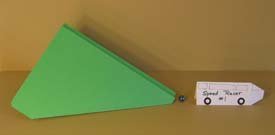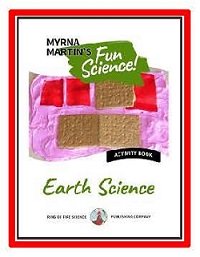Fun Science Experiment
Marble Powered Race Cars
In this fun science experiment kids create paper race cars out of index cards. The goal is to design a car that will go the farthest when powered by a marble that travels down a ramp and pushes the car across a flat surface.

Materials
- 4x6 inch index cards
- Scotch tape
- Scissors
- File folder
- Marble
- Tape measure
Directions
- Fold a 4x6 inch index card in half like a hot dog bun.
- At
the front of the race car cut a triangle off the top and bottom of the
card so it will not drag as it travels on the floor.
- Fold the trimmed
edges so they come together at a point at the front of the car.
- Decorate your paper car with windows, doors, and wheels. Tape the front end of the car after it is decorated.
- Create a ramp for your marble to roll down with a file folder.
Fold the bottom of the file folder so it creates a v.
- Fold the side
edges of the folder so it will sit on the floor evenly.
- Tape the bottom edges of the ramp after you have it folded the way you want.
- Set the ramp on the floor or some other flat surface. Place your
race car at the bottom of the ramp with the front facing forward and the
back at the very bottom of the ramp.
- Roll the marble down the ramp and
into the car.
- Mark the distance the car traveled.
- Set up the ramp, car and marble for a second run. Complete the
second run and make mark the distance the car traveled on its second
run.
- Repeat these steps for a third run. Measure the distance the cars traveled during each run with a tape measure.
- Figure out the average distance the car traveled by adding the three distances together. Divide this number by three to get the average distance traveled.
Try this fun science experiment again with a different car. Fold another index card in half and try to design a car that will travel further than your first model. Try using various sizes of index cards to see if the size of the card makes a different in the distance your cars travel.


Click for More Information and to Order
Science behind the experiment
The reason that your car stopped was because of friction. Friction is caused when two things rub against each other. The bottom of your car is in contact with the hard surface that you used for a race track.
If you were to use a rough surface for your race trace it would create more friction with the bottom of the car causing it to go slower and not travel as far.
More Links to Science Experiments
Gravity Experiments, Perfect Landing Astronauts in the early days of space exploration returned to Earth using parachutes to slow their descent. In this experiment you create a variety of parachutes and test them.
Water Cycle Experiments, Floaters and Sinkers Try these amazing science experiments and find out how insects can walk on water!
Magnetism Experiments, Navigating the Oceans Do you know how to create a compass using only a needle and magnet? Try this easy experiment and find out!
Physical Science Experiments, Swinging With Galileo Try these fun physical science experiments first done by Galileo. See if you can make things swing on a string by pushing one object to set all the hanging strings in motion.
Easy Science Experiments Lots of easy experiments for kids of all ages. Try a fun science experiment from this page.
Kids Fun Science Find out about science activities, experiments, plate tectonics and much more on this page.
Fun Science Experiment, Marble Powered Race Cars Create a ramp, a paper car and see how far you can make the car travel powered only by a marble!
KIDS FUN Science Bookstore
Check out Myrna Martin's award winning textbooks, e-books, videos and rock sets. The Kids Fun Science Bookstore covers a wide range of earth science topics. Click here to browse.










